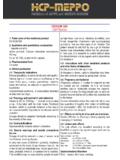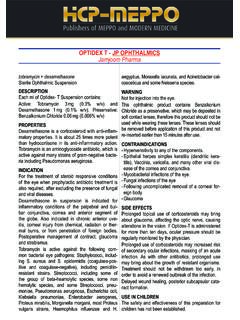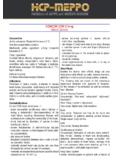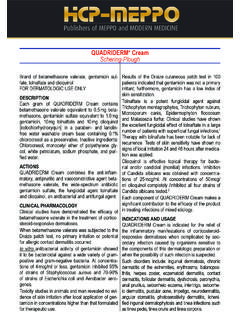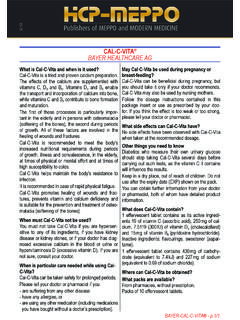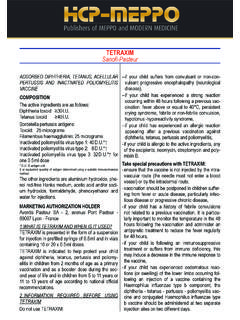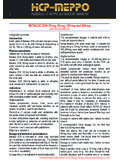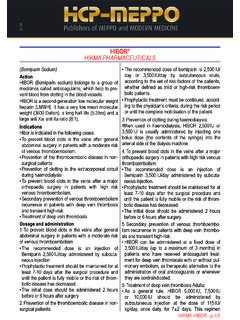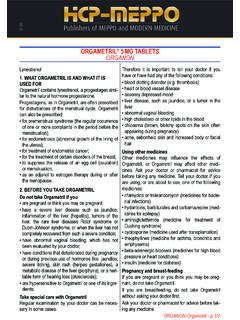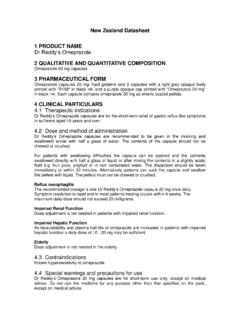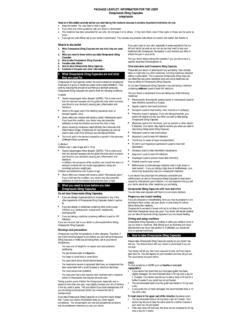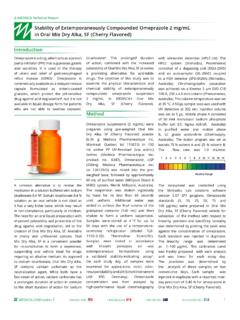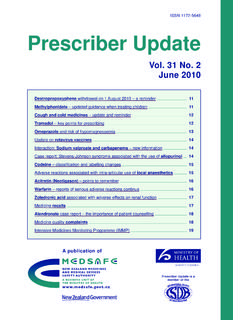Transcription of KLACID Abbott - Modern Medicine
1 10-14. KLACID . Abbott Clarithromycin Posology and method of administration DESCRIPTION AND COMPOSITION KLACID 250 mg tablets and 500 mg tablets: Adults: The usual dose is 250 mg twice daily for 7. KLACID 250 mg tablets: yellow, ovaloid, film-coat- ed tablet containing 250 mg clarithromycin days. This may be increased to 500 mg twice daily for up to 14 days in severe infections. KLACID 500 mg tablets: yellow, ovaloid, film-coat- Children older than 12 years: As for adults. ed tablet containing 500 mg clarithromycin KLACID 500 mg tablets for eradication of H. pylori in KLACID XL (Also known as KLACID RM, KLACID patients with duodenal ulcers: MR) 500 mg tablets: yellow, ovaloid, film-coated tablet containing 500 mg clarithromycin in a modi- Adults: fied-release preparation. Dual Therapy (14 days): KLACID granules 125 mg/5 ml: white to off- white The usual dose of Clarithromycin is 500 mg three granules for oral suspension. times daily for 14 days. Clarithromycin should be After mixing each 5 ml of suspension contains administered with oral omeprazole 40 mg once daily.
2 125 mg clarithromycin The pivotal study was conducted with omeprazole 40 mg once daily for 28 days. Supportive studies KLACID granules 250 mg/5 ml: white to off- white have been conducted with omeprazole 40 mg once granules for oral suspension. daily for 14 days. After mixing each 5 ml of suspension contains 250 mg clarithromycin Triple Therapy (7-14 days): Clarithromycin 500 mg twice daily and lansoprazole CLINICAL PARTICULARS 30 mg twice daily should be given with amoxycillin Therapeutic indications 1000 mg twice daily for 7-14 days. All Pharmaceutical forms: Triple Therapy (7 days): Treatment of infections caused by susceptible orga- Clarithromycin 500 mg twice daily and lansoprazole nisms. Indications include: 30 mg twice daily should be given with metronida- Upper respiratory tract infections for example, zole 400 mg twice daily for 7 days. sinusitis, tonsillitis and pharyngitis. Lower respiratory tract infections for example, Triple Therapy (7 days): acute and chronic bronchitis, and pneumonia.
3 Clarithromycin 500 mg twice daily and omepra- Skin and soft tissue infections of mild to moderate zole 40 mg daily should be given with amoxycillin severity for example, impetigo, erysipelas, folliculi- 1000 mg twice daily or metronidazole 400 mg twice tis, furunculosis, and infected wounds. daily for 7 days. KLACID granules 125 mg/5 ml and KLACID granules Triple Therapy (10 days): 250 mg/5 ml: Clarithromycin 500 mg twice daily should be given Treatment of acute otitis media with amoxycillin 1000 mg twice daily and omepra- zole 20 mg daily for 10 days. KLACID 500 mg tablets: Clarithromycin in the presence of acid suppression Elderly: As for adults. effected by omeprazole or lansoprazole is indicat- Renal impairment: Dosage adjustments are not usually ed for the eradication of H. pylori in patients with required except in patients with severe renal impair- duodenal ulcers. ment (creatinine clearance< 30 ml/min). If adjustment Abbott - KLACID - Abbott - KLACID - is necessary, the total daily dosage should be Contraindications reduced by half, 250 mg once daily or 250 mg Clarithromycin is contra-indicated in patients with twice daily in more severe infections.
4 Known hypersensitivity to macrolide antibiotic drugs KLACID maybe given without regard to meals as and other ingredients. food does not affect the extent of bioavailability. Clarithromycin and ergot derivatives should not be KLACID XL (Kiacid RM, KLACID MR) Tablets: co-administered. Concomitant administration of Adults: The usual recommended dosage is one clarithromycin and any of the following drugs is con- 500 mg modified-release tablet daily to be taken traindicated: cisapride, pimozide and terfenadine. with food. In more severe infections, the dosage can Elevated cisapride, pimozide and terfenadine levels be increased to two 500 mg modified-release tab- have been reported in patients receiving either of lets daily. The usual duration of treatment is 7 to 14 these drugs and clarithromycin concomitantly. This days. may result in QT prolongation and cardiac arrhyth- Children older than 12 years: As for adults. mias including ventricular tachycardia, ventricular Renal impairment: KLACID XL should not be used in fibrillation and Torsade de Pointes.
5 Similar effects patients with renal impairment (creatinine clearance have been observed with concomitant administra- less than 30 mUmin). KLACID immediate release tab- tion of astemizole and other macrolides. lets may be used in this patient population. KLACID XL: As the dose cannot be reduced from KLACID granules 125 mg/5 ml: For infants 6 months 500 mg daily, KLACID XL is contraindicated in patients and above, the recommended daily dosage is with creatinine clearance less than 30 ml/min. 15 mg/kg/day in two divided doses. The dose can Special warnings and precautions for use be increased according to the severity of illness and Clarithromycin is principally excreted by the liver and physician's opinion kidney. Caution should be exercised in administe- Child weight (kg) Dosage (ml) bid ring this antibiotic to patients with impaired hepatic or 5-10 ml renal function. Prolonged or repeated use of clarithro- 11-20 5 ml mycin may result in an overgrowth of non-susceptible 21-30 ml bacteria or fungi.
6 If super-infection occurs, clarithro- mycin should be discontinued and appropriate thera- KLACID granules 250 mg/5 ml: The usual duration py instituted. H. pylori organisms may develop resis- of treatment is for 5 to 10 days depending on the tance to clarithromycin in a small number of patients. pathogen involved and the severity of the condition. The recommended daily dosage of KLACID Paediatric There have been post-marketing reports of colchi- Suspension 250 mg/5 ml in children is given in the cine toxicity with concomitant use of clarithromycin following table and is based on a mg/kg twice and colchicine, especially in the elderly, some of a day dosage regimen. Doses up to 500 mg twice which occurred in patients with renal insufficiency. a day have been used in the treatment of severe Deaths have been reported in some such patients. infections. KLACID XL (Kiacid RM, KLACID MR) and KLACID peadi- atric suspension: patients with rare hereditary prob- KLACID PAEDIATRIC SUSPENSION 250 MG/5 ML DOSAGE.
7 IN CHILDREN. lems of fructose intolerance, glucose-galactose Weight *(kg) Approx Age(yrs) Dosage (ml) bid malabsorption or sucrase-isomaltase insufficiency should not take this Medicine . 8-11 1-2 12-19 3-6 Interactions with other medicaments and other 20-29 7-9 forms of interaction 30-40 10-12 5. Clarithromycin has been shown not to interact with * Children <8 kg should be dosed on a per kg basis oral contraceptives. As with other macrolide antibio- (approx. mg/kg twice a day) tics the use of clarithromycin in patients concurrently Abbott - KLACID - taking drugs metabolised by the cytochrome P450 adjustments should be considered: For patients with system (eg. Cilostazol, methylprednisolone, oral anti- CLCR 30 to 60 ml/min the dose of clarithromycin should coagulants (eg. warfarin), quinidine, sildenafil, ergot be reduced by 50%. For patients with CLCR <30 ml/. alkaloids, alprazolam, triazolam, midazolam, diso- min the dose of clarithromycin should be decreased pyramide, lovastatin, rifabutin, phenytoin, cyclospo- by 75%.)
8 Doses of clarithromycin greater than 1 g/day rine vinblastine, valproate and tacrolimus.) may be should not be coadministered with ritonavir. associated with elevations in serum levels of these For patients with renal impairment an immediate other drugs. Rhabdomyolysis, co-incident with the release form of clarithromycin should be used. coadministration of clarithromycin, and HMG-CoA There have been postmarketed reports of Torsade reductase inhibitors, such as lovastatin or simvas- de Pointes occurring with the concurrent use of clar- tatin has been reported. The administration of clar- ithromycin and quinidine or disopyramide. Levels of ithromycin to patients who are receiving theophyl- these medications should be monitored during clar- line has been associated with an increase in serum ithromycin therapy. theophylline levels and potential theophylline toxic- Post-marketing reports also indicate that co-admin- ity. The use of clarithromycin in patients receiving istration of clarithromycin with ergotamine or dihy- warfarin may result in potentiation of the effects of droergotamine has been associated with acute ergot warfarin.
9 Prothrombin time should be frequently toxicity characterized by vasospasm and ischaemia monitored in these patients. The effects of digoxin of the extremities and other tissues including the may be potentiated with concomitant administration central nervous system. of Clarithromycin. Monitoring of serum digoxin levels should be considered. Clarithromycin may potenti- Colchicine is a substrate for both CYP3A and ate the effects of carbamazepine due to a reduction the efflux transporter, P-glycoprotein (Pgp). in the rate of excretion. Clarithromycin and other macrolides are known to inhibit CYP3A and Pgp. When clarithromycin and Simultaneous oral administration of clarithromycin colchicine are administered together, inhibition of tablets and zidovudine to HIV infected adult patients Pgp and/or CYP3A by clarithromycin may lead to may result in decreased steady-state zidovudine increased exposure to colchicines. Patients should be levels. This can be largely avoided by staggering monitored for clinical symptoms of colchicine toxicity.
10 The doses of Clarithromycin and zidovudine by 1-2. hours. To date, this interaction does not appear to KLACID 250mg Tablets & KLACID 500mg Tablets: occur in paediatric HIV-infected patients taking klac- Although the Plasma Concentrations of clarithromy- id paediatric suspension ( KLACID 125 mg/5 ml gran- cin and omerprazole may be increased when they ules, KLACID 250 mg/5 ml granules) with zidovudine are administered concurrently, no adjustment to the or dideoxyinosine. dosage is necessary. At the dosages recommended, Interaction studies have not been conducted with there is no clinically significant interaction between KLACID XL and Zidovudine. If concomitant adminis- clarithromycin and lansoprazole. Increased plasma tration of clarithromycin and zidovudine is required, concentrations of clarithromycin may also occur then an immediate release formulation of clarithro- when it is co-administered with Maalox or ranitidine. mycin should be used. No adjustment to the dosage is necessary.
